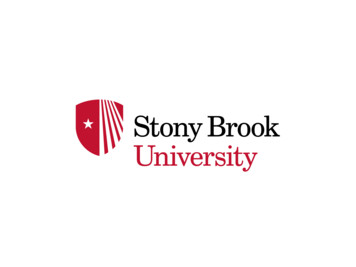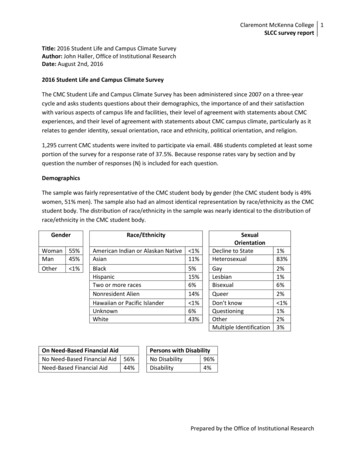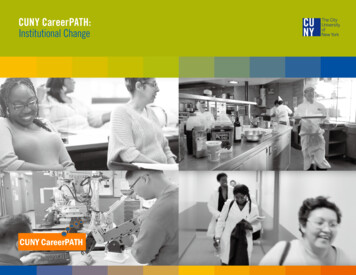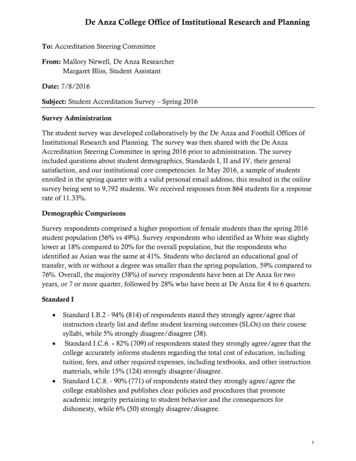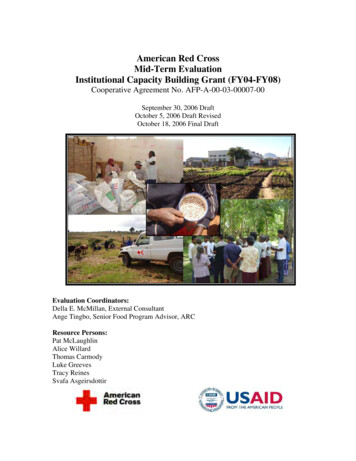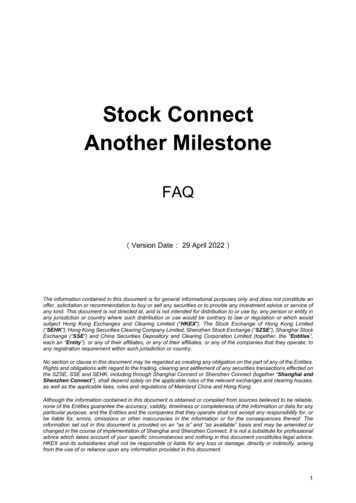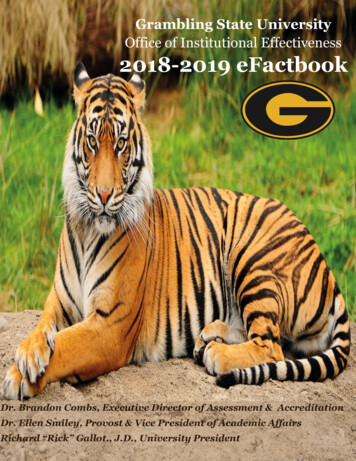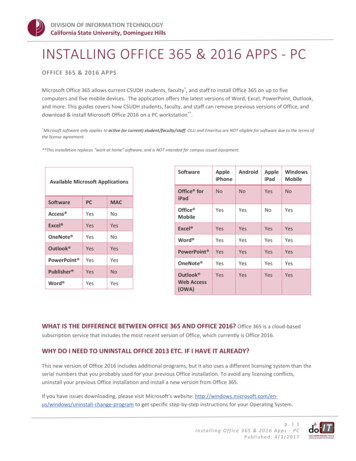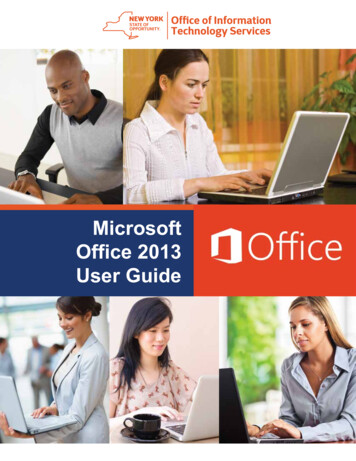
Transcription
USING RUBRICSTO ASSESS STUDENT L EARNING O UTCOMESAT THE P ROGRAM L EVELOFFICE of INSTITUTIONAL RESEARCH and ASSESSMENTJuly 2017
Table of ContentsUsing Rubrics to Assess Student Learning Outcomes at the Program Level . 3What are Rubrics? . 3What Do Rubrics Consist of? . 3What are the Benefits and Challenges of Using Rubrics? . 5How is a Rubric Created and Used in Assessing Program-Level Student Learning Outcomes? . 6More Questions and Answers about Using Rubrics in Program-Level Assessment of Student Learning Outcomes. 7Examples of Rubrics. 8Contact Information . 9Appendix A - Sample Rubrics Papers . 10Rubric for a Research Paper in the Humanities. 11Rubric for a Paper in the Social and Behavioral Sciences. 12Appendix B - Sample Rubrics Presentations . 14Scoring Rubric for General Oral Presentation . 15Poster Presentation Peer Scoring Rubric . 16Appendix C - Sample Rubrics Arts and Humanities . 17Rubric for Visual Arts . 18Rubric for Digital Media Project . 19Appendix D - Sample Rubrics Science and Math . 20Rubric for Conducting an Experiment in the Lab . 21Evaluation Rubric for Undergraduate Research Project in the Sciences . 22Science Lab Report Evaluation Rubric . 23Evaluation Rubric for Mathematical Proofs . 24Appendix E - Sample Rubrics Graduate Work . 25Evaluation Rubric for Thesis in Linguistics. 26Rubric for a Dissertation. 27Thesis Proposal Rubric. 30Appendix F - Sample Rubrics Miscellaneous . 31Undergraduate Internship Rubric . 32A Rubric for Rubrics . 33USING RUBRICS TO ASSESS STUDENT LEARNING OUTCOMES AT THE PROGRAM LEVELPAGE 2
Using Rubrics to Assess Student Learning Outcomesat the Program LevelWhat are Rubrics?A rubric is a scoring guide with criteria for evaluating students’ work in direct relation to one or more of theprogram’s learning outcomes and a rating scale indicating differing levels of performance.Rubrics are: Used to examine how well students have met learning outcomes rather than how wellthey perform compared to their peers. Typically include specific, observable, and measurable descriptors that defineexpectations at each level of performance for each criterion.They can be used to assess student performance in course assignments, exams, practica and internships, researchpapers, portfolios, group projects, public presentations, and many other types of work. The overall scores and anysubscales developed to measure more specific elements of performance are easily aggregated for further analysis atthe program level.What Do Rubrics Consist of?Holistic scales, checklists, rating scales, and analytic scales can be used in rubrics. Holistic scales allow the rater toassign a single score based on anoverall judgment of the student work.The holistic scales include globalindicators, but may lack specificfeedback needed to target studentgrowth.USING RUBRICS TO ASSESS STUDENT LEARNING OUTCOMES AT THE PROGRAM LEVELPAGE 3
Checklists are dichotomous (e.g. Yes/No; Met/Not Met) and easy to use; however, they may not providesubstantive information regarding the performance levels.YesInteractive Presentation ChecklistNoTime Management1. Did I use my time at an even pace, completing all sections of thepresentation?2. Did I set up and begin promptly?Organization3. Was the flow of my presentation and material logical and smooth?4. Were all the presented materials well-organized and readily available?Resource use5. Did I use different media to present my information?6. Did I use the most important media for the kind of information I presented?Audience Awareness7. Did I make frequent eye contact with my audience?8. Did I vary my voice to suit my presentation?9. Did I present my material in a way that suited my audience?Aesthetics10. Did I present myself in a professional way in my dress and grooming? 11. Did I hand out and use materials that were ascetically pleasing?Rating scales identify a range of performance without specific descriptors for each performance level (e.g.Exceeds Expectation/Meets Expectation/Below Expectation). They may not provide sufficient informationfor raters to score consistently and the feedback to students may not be specific enough for revision orfuture growth.Rating Scale Example: Computer Program Quality AssessmentExpected Learning Outcome: The student will write efficient, documented, error-free computer programsthat meet the specifications.Criteria for Success: A maximum of one item is rated as “Below Expectations”.Computer ProgramBelowMeetsExceedsExpectations 1Expectations 2Expectations 3CommentsAchieves what it was designed to doOperates without errorsSource code is efficientSource code is well- documentedExceeds Expectations Performance is above the expectations stated in the outcomes.Meets Expectations Performance meets the expectations stated in the outcomes.Below Expectations Performance does not meet the expectations stated in the outcomes.USING RUBRICS TO ASSESS STUDENT LEARNING OUTCOMES AT THE PROGRAM LEVELPAGE 4
Analytic scales articulate specific levels of performance for each individual criterion. Scoring using analyticscales is typically more consistent and specific areas of growth can be identified. The analytic scales takemore time to develop.Analytic Scale Rubric for Evaluating a Portfolio12PoorePortfolio is missing morePortfoliothan 4 minimumRequirement requirements as stated in thesyllabus.PoorNo use of graphics, InternetCreative use of resources, photographs,sound and /or video toTechnologyenhance ePortfolio andreflective statements.PoorMost artifacts and worksamples are unrelated to theArtifactspurpose of the course andportfolio.FairePortfolio is missing 3minimum requirements asstated in the syllabus.PoorThe text has many errors ingrammar capitalization,Organization &punctuation, and spellingWritingrequiring major editing andrevision.FairThe text has errors ingrammar, capitalization,punctuation, and spellingrequiring editing andrevision.ReflectionsPoorConsiderable difficulty inexpressing reflectionsdemonstrates level ofstudents' progress andknowledge development.Reflections incorporate thewhat, so what and now whatin artifacts.FairLittle use of graphics,Internet resources,photographs, sound and /orvideo to enhance ePortfolioand reflective statements.FairFew artifacts and worksamples are related to thepurpose of the course.FairDifficulty expressing andreflecting demonstrateslevel students' progress andknowledge development.Reflections incorporate thewhat, so what and nowwhat in artifacts.34ScoreGoodePortfolio meets allminimum requirements asstated in the syllabus.ExceptionalePortfolio meets allminimum and aboverequirements as stated inthe syllabus.GoodExceptionalSome use of graphics,Good use of graphics,Internet resources,Internet resources,photographs, sound and /or photographs, sound and /orvideo to enhance ePortfolio video to enhance ePortfolioand reflective statements. and reflective statements.GoodExceptionalMost artifacts and workAll artifacts and worksamples are related to the samples are clearly andpurpose of the course and directly related to theportfolio.purpose of the course andportfolio.GoodExceptionalThe text has a few errors in The text has no errors ingrammar, capitalization,grammar, capitalization,punctuation, and spellingpunctuation, and spelling.requiring editing andEasy to read and navigate.revision. Easy to read andnavigate.GoodExceptionalMost reflectionsAll reflections demonstratedemonstrate students'students' progress andprogress and knowledgeknowledge development.development. Reflections Reflections incorporate theincorporate the what, sowhat, so what and nowwhat and now what inwhat in artifactsartifacts.What are the Benefits and Challenges of Using Rubrics?Benefits – Establishes shared expectations and assessment practices, especially when faculty members collaborate todevelop themCan be used to evaluate student work consistentlyMake it more efficient to assess multifaceted examples of student work or performanceChallenges – Take time and effort to developNeed to include descriptions of specific criteria, and preferably exemplars of student work to benchmarkdifferent levels of performanceMay be a less precise measure because of the broad range of performance within each specified levelUSING RUBRICS TO ASSESS STUDENT LEARNING OUTCOMES AT THE PROGRAM LEVELPAGE 5
How is a Rubric Created and Used in Assessing Program-Level Student LearningOutcomes?1. First, review each of the program’s student learning outcomes.Where in the program do students have opportunities todemonstrate that they have achieved each of the outcomes?Capstone courses, senior or upper level courses, research orinternship experiences, comprehensive exams, dissertationdefenses, etc.?2. Once you have mapped the outcomes to the courses, exams,and other activities within the program, what specificassignments or means of demonstrating skill can serve as asource of student work that can be assessed in relation to thelearning outcome?How to Create and Use a Rubric Review SLOs Identify Student Work Establish Criteria Identify Scale Determine Range and Target Conduct Pilot Develop Sampling Plan Aggregate Scores3. Establish the criteria. What are the performance dimensions associated with the learning outcome? What arethe critical components of the student performance that you need to capture as evidence of learning whenassessing the work?4. Identify the scale. What is the appropriate scale for measuring each student’s performance on thesedimensions? Holistic scales – provide an overall evaluation; appropriate for assessment that does not require specificfeedback;Checklist – appropriate for assessment criteria that can be addressed using a dichotomous scale (e.g.Yes/No);Rating scales – provide feedback on the performance level; appropriate for assessment that does notrequire specific description of each performance level;Analytic scales – provides detailed description of each performance level.5. Determine the range of performance levels and the program’s target. The target is the average performanceor percentage of students who achieved a certain score target that the program aspires to or considers to be aminimum threshold for success in achieving the learning outcome. The number of performance levels may vary. Many people start with a 3-point scale (e.g. ExceedsExpectation/Meet Expectation/Below Expectation), 4-point scale (e.g. Outstanding/Good/ Average/Poor), or5-point scale (e.g. 6. Pilot the rubric. Is the rubric valid and reliable? Share the rubric with colleaguesTest the rubric on samples of student workIf you are using multiple raters, hold a session to discuss common definitions, standards, and expectationsfor quality. Practice using the rubric on the same pieces of work and comparing ratings to determine theconsistency in judgments across raters.7. Develop your sampling plan for selecting work to be assessed with the rubric.USING RUBRICS TO ASSESS STUDENT LEARNING OUTCOMES AT THE PROGRAM LEVELPAGE 6
8. Aggregate the rating scores across the entire sample. Compare the results to the program’s target forperformance on that learning outcome.After implementing the rubric, continue to review the findings. In addition to proving a consistent method forassessing student work, rubrics can identify opportunities for program improvement. Trends uncovered throughaggregated rubric scores can determine areas where students need additional instruction or support, as well asinform changes in the curriculum or how content is taught.More Questions and Answers about Using Rubrics in Program-Level Assessment ofStudent Learning OutcomesQuestion: Do rubrics have to be created and used in assessing all student work to measure achievement ofexpected learning outcomes?Answer: No. There are a number of different methods of assessing program-level student learningoutcomes. However, there are advantages to using rubrics, including greater reliability and consistency inrating performance across the program, the ease with which scores can be aggregated across the programto do more sophisticated analysis, and the ability to examine different dimensions of performance asopposed to just an overall grade or score.Question: Why can’t we just use average course grades to assess student achievement of learning outcomes?Answer: Accreditors do not recommend using course grades to assess learning outcomes. They argue thatcourse grades, especially at the undergraduate level, often include class participation, attendance, and otherbehavior not directly related to the learning outcomes. Further, average final grades provide no insights intorelative strengths and weaknesses of students across the various components of the outcome. CarnegieMellon University’s website offers a useful description of the differences between course grades andassessment of program-level learning outcomes. Instead, assess a specific assignment within one or more coursesthat maps to the learning outcome of interest.Question: Is there ever a situation in which we can use average course grades as evidence of achieving programlevel learning outcomes?Answer: This may be possible at the graduate level if you can document that that 100% of the course gradewas based on the quality of a paper, research project, or final exam that directly measured the learningoutcome. But if a graduate program has a comprehensive or qualifying exam or dissertation proposal thatmeasures the knowledge covered in the required core courses, why not just use the performances on thosemilestones as evidence of achievement of the outcome? Reporting on course grades would be redundant.Question: We mapped our undergraduate level student learning outcome for research skills to the final paper inour capstone course, which reports the procedures and results of their semester-long project. The courseinstructor graded the papers measuring competency in each of the stages of the research process. Do we need tohave additional faculty independently re-evaluate the papers using a formal rubric?Answer: No. When there is such a close fit between the learning outcome and the work being used toassess it, the scores or ratings originally assigned by the instructor can probably be used as evidence as towhether students are achieving the outcome. Most of the time, no one is more qualified to evaluate thework than the person who taught the course. For the department’s annual Student Learning OutcomesAssessment Report, the instructor could prepare a brief report for the DUS or undergraduate studiescommittee that includes a description of the assignment, a copy of the rubric or grading scheme used, theresults of the analysis of student performance, observations about strengths and weaknesses, andrecommendations for improving student learning related to the research skills outcome.USING RUBRICS TO ASSESS STUDENT LEARNING OUTCOMES AT THE PROGRAM LEVELPAGE 7
Question: To assess our learning outcome related to critical thinking skills, we plan to sample final papers from a setof senior-level courses in our major and have them rated by two faculty members with a rubric designed to measurecritical thinking. Some faculty have criticized this plan, saying that it is a poor use of time to re-grade student workand that averaging final course grades across the set of courses should provide sufficient data for this assessmentexercise. In addition, concerns were expressed that having other faculty not associated with the course re-gradeanother faculty member’s papers sends a message of distrust and raises questions about their academic freedom tomake judgments about student performance in their own courses. How do I explain this?Answer: The papers will be used for a secondary analysis to assess whether students are achieving a singleprogram-level outcome. This is not the same as having the papers completely re-graded by independentraters using the same criteria as the original instructor. The instructors no doubt evaluated the papers withadditional expectations unique to their particular courses, such as specific subject matter knowledge. Theymight have taken critical thinking skills into account when grading the papers, but unless common criteria forthis competency were used across instructors and assignments, aggregating the course grades will notprovide very reliable information about whether seniors have achieved this specific skill.In addition, it is important for all involved to understand that the assessment of learning outcomes isstudent-focused; it is not used to evaluate instructors. And, there is no reason to exclude the original courseinstructors from rating the papers for evidence of critical thinking skills, although it is a good idea have themrate papers that they have not already read for another purpose.In selecting the courses and papers for use in this exercise, the raters will need to ensure that the differentassignments provided comparable opportunities for students to demonstrate critical thinking skills. Ratersshould meet to reach a common understanding of the rubric and how it is to be applied, and to test theconsistency of their ratings.Examples of RubricsExamples of rubrics used by other institutions to evaluate different kinds of student work are provided in theAppendix. They can be used as models, or you can copy and adapt them for your own purposes. However, pleasebe sure to acknowledge the source (listed under each matrix) of each instrument if you distribute it.Another great source for rubrics is the American Association of Colleges and Universities’ (AAC&U) Valid Assessmentof Learning in Undergraduate Education (VALUE) project. This set of 16 rubrics includes the following that arerelevant for measuring a number of learning outcomes across majors:Critical ThinkingOral CommunicationCreative ThinkingQuantitative LiteracyInquiry and AnalysisProblem SolvingWritten CommunicationIntegrative and Applied LearningThe VALUE rubrics, which are being used by hundreds of institutions, are free and can be downloaded from AAC&U’swebsite: http://www.aacu.org/value/rubrics .USING RUBRICS TO ASSESS STUDENT LEARNING OUTCOMES AT THE PROGRAM LEVELPAGE 8
Contact InformationFor more information about assessment resources, including rubrics, please go /assessment-resources/Please feel free to contact the Office of Institutional Research & Assessment for help:Dr. Bryant Hutson, Interim Director of Assessmentbhutson@email.unc.eduUSING RUBRICS TO ASSESS STUDENT LEARNING OUTCOMES AT THE PROGRAM LEVELPAGE 9
Appendix ASample Rubrics PapersUSING RUBRICS TO ASSESS STUDENT LEARNING OUTCOMES AT THE PROGRAM LEVELPAGE 10
Rubric for a Research Paper in the HumanitiesExcellentStrong introduction of topic’skey question(s), terms.Clearly delineates subtopicsto be reviewed. Specific thesisstatement.GoodConveys topic and keyquestion(s). Clearly delineatessubtopics to be reviewed.General thesis statement.AcceptableConveys topic, but not keyquestion(s). Describessubtopics to be reviewed.General theses statement.UnacceptableDoes not adequately conveytopic. Does not describesubtopics to be reviewed.Lacks adequate thesesstatement.Focus &SequencingAll material clearly related tosubtopic, main topic. Strongorganization and integration ofmaterial within subtopics.Strong transitions linkingsubtopics, and main topic.All material clearly related tosubtopic, main topic andlogically organized withinsubtopics. Clear, variedtransitions linking subtopics,and main topic.Most material clearlyrelated to subtopic, maintopic. Material may not beorganized withinsubtopics. Attempts toprovide variety oftransitionsLittle evidence material islogically organized into topic,subtopics or related to topic.Many transitions are unclearor nonexistent.SupportStrong peer- reviewedresearch based support forthesis.Sources well selected tosupport thesis with someresearch in support of thesis.Sources generallyacceptable but not peerreviewed research(evidence) based.Few sources supportingthesis. Sources insignificantor unsubstantiated.ConclusionStrong review of keyconclusions. Strongintegration with thesisstatement. Insightfuldiscussion of impact of theresearched material on topic.Strong review of keyconclusions. Strong integrationwith thesis statement.Discusses impact of researchedmaterial on topic.Review of keyconclusions. Someintegration with thesisstatement. Discussesimpact of researchedmaterial on topic.Does not summarizeevidence with respect tothesis statement. Does notdiscuss the impact ofresearched material on topic.Grammar &MechanicsThe paper is free ofgrammatical errors andspelling & punctuation.Grammatical errors or spelling& punctuation are rare and donot detract from the paper.Very few grammatical,spelling or punctuationerrors interfere withreading the paper.Grammatical errors orspelling & punctuationsubstantially detract from thepaper.CommunicationScholarly style. Writing isflowing and easy to follow.Scholarly style. Writing hasminimal awkward of unclearpassages.Word choice occasionallyinformal in tone. Writinghas a few awkward orunclear passages.Word choice is informal intone. Writing is choppy, withmany awkward or unclearpassages.Citations &ReferencesAll references and citationsare correctly written andpresent No errors in MLAstyle.Rare errors in MLA style that donot detract from the paper.Scholarly style. Writing hasminimal awkward of unclearpassages.Errors in MLA style arenoticeable. Word choiceoccasionally informal intone. Writing has a fewawkward or unclearpassages.Reference and citation errorsdetract significantly frompaper.Introduction(Adapted from the University of Kentucky)USING RUBRICS TO ASSESS STUDENT LEARNING OUTCOMES AT THE PROGRAM LEVELPAGE 11
Rubric for a Paper in the Social and Behavioral SciencesFocus ExemplaryRelevant research isthoroughly and completelydiscussed.Key concepts areidentified andoperationally defined.Objective stancemaintained throughoutdocument. AccomplishedRelevant research isadequately addressed.Most of the key conceptsare identified andoperationally defined.Contains some irrelevantinformation but does notdetract from focus.Objective stance mostlymaintained. OrganizationandDevelopment Organization anddevelopment of content islogical and is welldeveloped.Hypotheses/Aims/Objectives are clearly formulatedand articulated.Conclusion is fully andclearly articulated. Organization anddevelopment of content islogical with minimal errors.Content and central ideasdeveloped.Hypotheses/Aims/Objectives are adequatelyformulated and articulated.Conclusion is adequatelyand clearly articulated. DevelopingPaper addresses the relevantresearch generally satisfactorily,though explanations andelaborations may be imprecise.Most of the key concepts areidentified and operationallydefined, though the definitions maybe imprecise.Contains some irrelevantinformation but does notsignificantly detract from focus.Objectivity mostly maintained,though occasional subjectiveremarks occur.Organization and development ofcontent is adequate.Contents not well developed.Hypotheses/Aims/Objectives arestated, but may lack precision andclarity.Conclusion is stated, but lacksprecision and clarity. Style Research Sophisticated and variedsentence structure andlength.Objective, efficientacademic language. Flawless APA format anddocument design.Unfailingly correct in-textcitations.Flawless referencesection.Complete absence ofplagiarism. Frequently varied sentencestructure and length withrare style or structureerrors.Mostly objective, efficientacademic language. Mostly appropriate APAsection headings andSubheadings. Infrequenterrors in in-text citations.Occasional errors inreference section.Complete absence ofplagiarism. Occasional variation in sentencestructure and length.Generally, pragmatically adequate,though some informal style mayappear. Some lapses in APA conformity.Paper sections occasionallyinconsistent with APA.Some errors in in-text citations andin reference section.Complete absence of plagiarism. BeginningPaper does not adequatelyaddress the relevantresearch.Very few key concepts areidentified and clearlydefined.Paper contains too muchirrelevant information thatseriously detracts fromfocus.Frequent subjectiveintrusions. Organization anddevelopment of content isinsufficient.Content is not developed.Hypotheses/Aims/Objectives are poorlystated and do not becomeevident until the end.Conclusion is poorlystated, and is faultyPaper has many problemswith structure. No variation in sentencestructure – very simplesyntax, short and simplesentences.Style frequentlypragmatically inadequatewith excess informallanguage.Frequent lapses in APAconformity.Paper sections frequentlyAPA inconsistent.Frequent errors in in-textcitations and in referencesection.Complete absence ofplagiarism. (Adapted from Texas A&M University)USING RUBRICS TO ASSESS STUDENT LEARNING OUTCOMES AT THE PROGRAM LEVEL PAGE 12 UnacceptableRelevant research notdiscussed.Key concepts either notidentified or are identifiedin a confusing manner.Contains irrelevantinformation.Very frequent subjectiveremarks.Organization anddevelopment lacking.Content and central ideasare not developed.Hypotheses/Aims/Objectives are not stated and donot become evident untilthe end.Conclusion is not stated.Paper has no logic andparagraphs are randomand lack explanation.No variation in sentencestructure – very simple andfrequently erroneoussyntax.Very short sentences.Style mostly pragmaticallyinadequate with excessinformal language.Paper mostly APAinconsistent.Widespread errors in intext citations and inreference section.Evidence of plagiarism.
Rubric for Grading an Essay ExamCriteria & PointsAssignedMissing or SeriousProblemsBelowExpectationsMeets ExpectationsExcellent Work0123Relevance ofanswer to thequestionThe essay did notanswer the question.Answer isincomplete.Excessivediscussion ofunrelated issuesand/or significanterrors in content.Answer is brief withinsufficient detail.Unrelated issueswere introducedand/or minor errorsin content.Answer is complete;sufficient detailprovided to supportassertions; answerfocuses only on issuesrelated to the question;factually correct.Thoroughness ofanswerNone of the relevantdetails wereincluded.Serious gaps in thebasic detailsneeded.Most of the basicdetails are includedbut some aremissing.Deals fully with theentire question.Organization andlogic of answerWeak organization;sentences rambling;ideas are repeated.Minor problems oforganization or logic;Needs work oncreating transitionsbetween ideas.Clear and logicalpresentation; gooddevelopment of anargument;Transitions aremade clearly andsmoothly.Mechanics ofwriting (spelling,punctuation,grammar, clarity ofprose)M
samples are clearly and directly related to the purpose of the course and portfolio. Organization & Writing. Poor The text has many errors in grammar capitalization, punctuation, and spelling requiring major editing and revision. Fair The text has errors in grammar, capitalization, punctuation, and spelling
